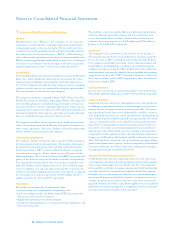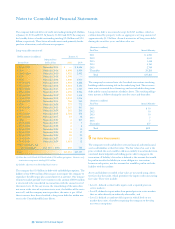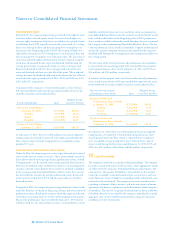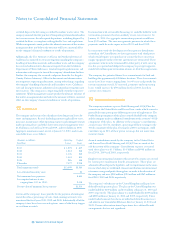Walmart 2010 Annual Report Download - page 41
Download and view the complete annual report
Please find page 41 of the 2010 Walmart annual report below. You can navigate through the pages in the report by either clicking on the pages listed below, or by using the keyword search tool below to find specific information within the annual report.
The disclosure of fair value of certain financial assets and liabilities that is recorded at cost is as follows:
Cash and cash equivalents: The carrying amount approximates fair value due to the short maturity of these instruments.
Long-term debt: The fair value is based on the company’s current incremental borrowing rate for similar types of borrowing arrangements
or, where applicable, quoted market prices. The cost and fair value of our debt as of January 31, 2010 and 2009 is as follows:
January 31, 2010 January 31, 2009
(Amounts in millions) Cost Fair Value Cost Fair Value
Long-term debt $37,281 $39,055 $37,197 $37,862
Additionally, as of January 31, 2010 and 2009, the company held certain derivative asset and liability positions that are required to be measured at fair
value on a recurring basis. The majority of the company’s derivative instruments relate to interest rate swaps. The fair values of these interest rate
swaps have been measured in accordance with Level 2 inputs of the fair value hierarchy. As of January 31, 2010 and 2009, the notional amounts and
fair values of these interest rate swaps are as follows (asset/(liability)):
(Amounts in millions) January 31, 2010 January 31, 2009
Derivative financial instruments designated for hedging: Notional Amount Fair Value Notional Amount Fair Value
Receive fixed-rate, pay floating-rate interest rate swaps designated as fair value hedges $4,445 $260 $5,195 $321
Receive fixed-rate, pay fixed-rate cross-currency interest rate swaps
designated as net investment hedges (Cross-currency notional amount:
GBP 795 at January 31, 2010 and 2009) 1,250 189 1,250 526
Receive floating-rate, pay fixed-rate interest rate swaps designated as cash flow hedges 638 (20) 462 (17)
Receive fixed-rate, pay fixed-rate cross-currency interest rate swaps
designated as cash flow hedges 2,902 286 — —
Total $9,235 $715 $6,907 $830
The fair values above are the estimated amounts the company would receive or pay upon a termination of the agreements relating to such instru-
ments as of the reporting dates.
Notes to Consolidated Financial Statements
Walmart 2010 Annual Report 39
6 Derivative Financial Instruments
The company uses derivative financial instruments for hedging and
non-trading purposes to manage its exposure to changes in interest and
currency exchange rates, as well as to maintain an appropriate mix of
fixed- and floating-rate debt. Use of derivative financial instruments in
hedging programs subjects the company to certain risks, such as market
and credit risks. Market risk represents the possibility that the value of
the derivative instrument will change. In a hedging relationship, the
change in the value of the derivative is offset to a great extent by the
change in the value of the underlying hedged item. Credit risk related
to derivatives represents the possibility that the counterparty will not
fulfill the terms of the contract. The notional, or contractual, amount
of the company’s derivative financial instruments is used to measure
interest to be paid or received and does not represent the company’s
exposure due to credit risk. Credit risk is monitored through established
approval procedures, including setting concentration limits by counter-
party, reviewing credit ratings and requiring collateral (generally cash)
from the counterparty when appropriate.
The company’s transactions are with counterparties rated “A+” or better
by nationally recognized credit rating agencies. In connection with
various derivative agreements with counterparties, the company held
cash collateral from these counterparties of $323 million and $440
million at January 31, 2010 and 2009, respectively. It is our policy to
record cash collateral exclusive of any derivative asset, and any collateral
holdings are reflected in our accrued liabilities as amounts due to the
counterparties. Furthermore, as part of the master netting arrangements
with these counterparties, the company is also required to post collat-
eral if the derivative liability position exceeds $150 million. The
company has no outstanding collateral postings and in the event of
providing cash collateral, the company would record the posting as a
receivable exclusive of any derivative liability.
When the company uses derivative financial instruments for purposes of
hedging its exposure to interest and currency exchange rates, the contract
terms of a hedge instrument closely mirror those of the hedged item,
providing a high degree of risk reduction and correlation. Contracts that
are effective at meeting the risk reduction and correlation criteria are
recorded using hedge accounting. If a derivative instrument is a hedge,
depending on the nature of the hedge, changes in the fair value of the
instrument will either be offset against the change in fair value of the
hedged assets, liabilities or firm commitments through earnings or be
recognized in accumulated other comprehensive loss until the hedged
item is recognized in earnings. The ineffective portion of an instrument’s
change in fair value will be immediately recognized in earnings.
Instruments that do not meet the criteria for hedge accounting, or
contracts for which the company has not elected hedge accounting,
are valued at fair value with unrealized gains or losses reported in
earnings during the period of change.
























